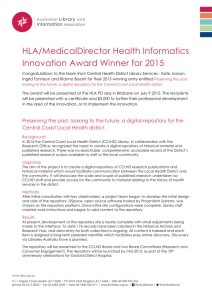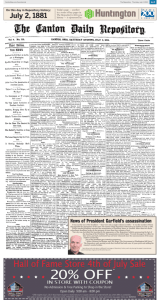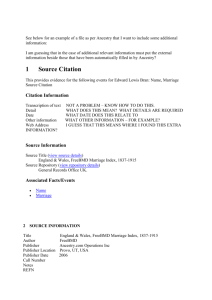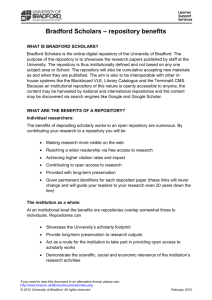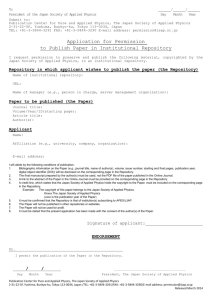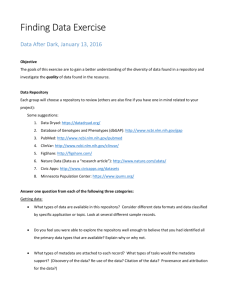Survey of University Repositories
advertisement
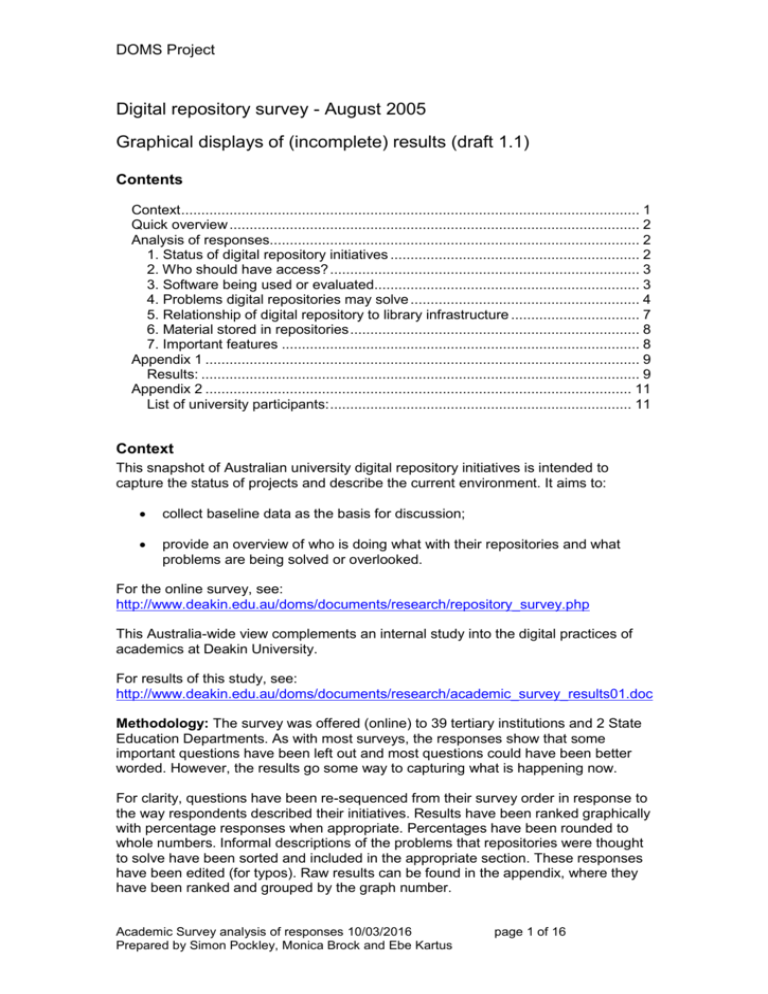
DOMS Project Digital repository survey - August 2005 Graphical displays of (incomplete) results (draft 1.1) Contents Context .................................................................................................................. 1 Quick overview ...................................................................................................... 2 Analysis of responses............................................................................................ 2 1. Status of digital repository initiatives .............................................................. 2 2. Who should have access? ............................................................................. 3 3. Software being used or evaluated.................................................................. 3 4. Problems digital repositories may solve ......................................................... 4 5. Relationship of digital repository to library infrastructure ................................ 7 6. Material stored in repositories ........................................................................ 8 7. Important features ......................................................................................... 8 Appendix 1 ............................................................................................................ 9 Results: ............................................................................................................. 9 Appendix 2 .......................................................................................................... 11 List of university participants: ........................................................................... 11 Context This snapshot of Australian university digital repository initiatives is intended to capture the status of projects and describe the current environment. It aims to: collect baseline data as the basis for discussion; provide an overview of who is doing what with their repositories and what problems are being solved or overlooked. For the online survey, see: http://www.deakin.edu.au/doms/documents/research/repository_survey.php This Australia-wide view complements an internal study into the digital practices of academics at Deakin University. For results of this study, see: http://www.deakin.edu.au/doms/documents/research/academic_survey_results01.doc Methodology: The survey was offered (online) to 39 tertiary institutions and 2 State Education Departments. As with most surveys, the responses show that some important questions have been left out and most questions could have been better worded. However, the results go some way to capturing what is happening now. For clarity, questions have been re-sequenced from their survey order in response to the way respondents described their initiatives. Results have been ranked graphically with percentage responses when appropriate. Percentages have been rounded to whole numbers. Informal descriptions of the problems that repositories were thought to solve have been sorted and included in the appropriate section. These responses have been edited (for typos). Raw results can be found in the appendix, where they have been ranked and grouped by the graph number. Academic Survey analysis of responses 10/03/2016 Prepared by Simon Pockley, Monica Brock and Ebe Kartus page 1 of 16 DOMS Project Quick overview The digital repository environment in Australia is prototypical and in a state of evolution. Most universities are engaged in investigating, evaluating, or demonstrating the effectiveness of a digital repository. The larger projects are intended to improve accessibility to research. This is essentially a reflection of their source of funding. At a local level it translates into a desire to improve the research profile of the university, as well as a need to improve the management and access to all kinds of digital material. For this reason, repositories are mainly intended to be stores for scholarly publications and/or learning objects. However, less than half of the universities have a written business case for establishing a repository. More than half of the proposed repositories are intended to be accessible only to members of the university community. The most common software being evaluated or deployed is DSpace, E-Prints, Harvest Road or Learning Edge. The features considered to be most important to a repository are: ease of use, along with access and version control. Analysis of responses 1. Status of digital repository initiatives in universities There are many grey areas when it comes to identifying digital repository initiatives. Most (probably all) universities have numerous existing and planned data stores in which digital material is (or is intended to be) indexed, searched and accessed. That these are often stand-alone or narrow in scope with varying degrees of restricted access can be understood as part of the problem being addressed by many of the digital repository initiatives. Caveat: Some respondents referred to subject or library-based data stores (e.g. eReserve) as a central repository but noted the need to integrate or upgrade for wider use. Many expected that they might eventually be replaced or evolve into a central digital repository. The status of an existing repository and a planned repository was often perceived as a continuum and not clearly separated. Conversely, many universities who participate in the ADT project did not mention it. While the ARROW project was described by its leader as a ‘demonstrator,’ its members appeared to regard it as an implemented project. Graph 1. Status of central repository initiatives Investigating/planned 11 Demonstrator/pilot 7 Evaluating 4 Not planned 4 Developing Implemented 3 1 Academic Survey analysis of responses 10/03/2016 Prepared by Simon Pockley, Monica Brock and Ebe Kartus page 2 of 16 DOMS Project 2. Who should have access to the repository? The university community includes academic staff, general staff and students. Most respondents who described an open access environment also noted that some material would need to have restricted access, these are labelled as Part open – part restricted. Graph 2. Who should use the digital repository? University community 12 Academics (mainly) 7 Open access to anyone 5 Part open - part restricted 3 Librarians and Ed. Developers 3 No response 4 3. Repository software being used or evaluated Caveat: The graph should not be seen as showing what software is most widely deployed. Most software is being investigated, evaluated, or tested, rather than deployed. There is also a grey area between the role of content management systems (CMS), local stores, and central repositories. Graph 3 shows the extent to which various software applications are either being used or evaluated. For example, where a university is evaluating DSpace, Fedora, Learning Edge and Harvest Road, each one will score a point. Academic Survey analysis of responses 10/03/2016 Prepared by Simon Pockley, Monica Brock and Ebe Kartus page 3 of 16 DOMS Project Graph 3. What repository software is being considered Dspace 7 Fedora 7 Learning Edge 7 Harvest Road 6 E-Prints 6 SQL 4 ETD - (ADT) Others: Masterfile,OJS, PKP, OCS, Innovative Interfaces Oracle 4 3 3 E-Reserve 2 TeamSite 2 Open source 1 None, or to be decided 8 4. Problems digital repositories may solve There are a range of motivations for establishing a digital repository. Responses contained manifold issues that have been grouped and summarised in Graph 4. Academic Survey analysis of responses 10/03/2016 Prepared by Simon Pockley, Monica Brock and Ebe Kartus page 4 of 16 DOMS Project Graph 4. What problem does (will) your repository solve? Improve access to university material 54% Improve research and scholarly profile 46% Better management of digital material 42% Improve copyright managment 27% Facilitate reuse/sharing/collaboration 19% Improve access to digital theses 15% Facilitate long-term access 15% Store metadata 8% One place to put all our theses and all research output. Academics have found that the repository is a place where they can input their research, obtain persistent URLs and put the URL on their web sites without worrying about server space. Allows our theses to be more readily accessed. When it becomes mandatory to deposit a digital version of all theses, then this will be a valuable resource for researchers. An added benefit will be reducing the need for ILL to photocopy theses to fulfil requests. ADT – Ready and easy access via the web to information contained in Australian research theses to the worldwide community. Greater recognition by the international research community. Greater access to a valuable but underutilised information resource the whole Australian research community ARROW – Provide an infrastructure for the stewardship of digital research materials in the long-term. Increase the visibility and accessibility of university researchers and research. Capture, maintain and preserve university research as part of the official record of intellectual output. Increase the diversity of scholarly research that is captured, accessed and managed. Teamsite - better mgt of web content and ability to change brand easily ARROW - research performance mgt. and visibility. LearningEdge - get a sense of what a LCMS can do It helps to maximise research impact (by providing open access to the text), it provides a single showcase for University research output and it facilitates research sharing and collaboration Long term access to and storage of academic research. Greater visibility and exposure of our research internationally. No need for password/authentication to Academic Survey analysis of responses 10/03/2016 Prepared by Simon Pockley, Monica Brock and Ebe Kartus page 5 of 16 DOMS Project get full text of some materials. Its persistent identifiers keep material available. The preservation metadata will help with format changes and obsolescence. One stop shop for data of all different kinds, including admin, archives, records etc. Possibly also the solution for academic portfolios, DEST reporting and so on. Bringing disparate collections maintained by many people into one institutional collection resourced by the university as a whole. Increase access to total research output of university. Areas in the arts and humanities have research that is less well recognised. Dispersal of content which makes many resources inaccessible and the need of the school involved to bring it\'s research output together in a way that allows it to be showcased. provide a forum for epublishing of the scholarly output of the university using open source software; facilitate access to this output; increase the research profile of the University; raise awareness about the issues associated with electronic scholarly publishing; support the information needs of the research community Equity of access, security, support of distance and flexible education, promotion and dissemination of research work carried out at university (i.e. increasing the research profile of university. Space and access from remote sites They [various repositories] are just tools to help us manage digital objects - don\'t really solve any problems (maybe create a few though). Provides a store for metadata describing the Dept.\'s learning resources. The metadata will conform to a common standard to facilitate search, discovery and management of these resources. Putting past exam papers / course recommended readings / rare books online Distributed management of digital learning objects. Copyright management. Access to committee records, both non confidential public (university only) versions and full confidential versions with full text search capabilities across all documents in the system. Management of course readings and other copyrighted documents. Same content present on multiple websites in different versions. ‘Discoverability’ of course materials and corporate documents. Could reduce the duplication of resources across multiple subjects and introduce version control leading to more efficient and effective development and deployment of resources. Inadequate descriptions, restricted access times, no online access, access to fragile material Preservation of digital materials related to research. Access to research output. Coherent organisation of research output. Academic Survey analysis of responses 10/03/2016 Prepared by Simon Pockley, Monica Brock and Ebe Kartus page 6 of 16 DOMS Project Dedicated copyright database for non-university digital objects, eg e-Reserve and online Readings; work-flows for learning materials development and revision, and search facility; e-thesis workflows, storage and search facility; other digital object storage and search facility. Rights management. Re-use/sharing of content 1. Copyright compliance and resources searchable by Course and academic as well as by citation and keyword. 2. Searchability, Authoring and version control and reusability of learning objects. 3. Access, marketing and reporting of research output Copyright compliance Paper wastage, legal compliance (copyright), readily available 24x7 access to documents; reduces workloads; provides management information The Reusable Learning Objects (RLO) Repository will enable greater sharing of quality content which will improve learning outcomes, deliver greater ROI from the development of resources, provide greater opportunities for collaboration, save time for academics to devote to research, T&L improvements or student contact. The repository will also assist in the management of the University\'s resources. 5. Relationship of digital repository to library infrastructure A significant number of digital repository projects have been developed outside the orbit of university library management systems. However, the need for a digital repository has most commonly been articulated by members of the library community. Those initiatives that are integrated with the library management systems tend to be smaller in scope or more focussed on a particular form of digital content such as e-readings. That the greater proportion of repository initiatives is not integrated with the library systems is an interesting phenomenon worth further study. Graph 5. Relationship of repository to Library 46% No relationship to library systems Separate - with links to library catalogue 23% 19% Relationship yet to be defined Integrated with library systems 12% Academic Survey analysis of responses 10/03/2016 Prepared by Simon Pockley, Monica Brock and Ebe Kartus page 7 of 16 DOMS Project 6. Material stored in repositories Graph 6. What kinds of digital will be stored in the repository? 40% learning objects scholarly publications 36% research 24% theses 24% exam papers 24% 20% e-readings copyrighted material 16% 8% datasets unit outlines 4% metadata 4% university records 4% 7. Important features Academic Survey analysis of responses 10/03/2016 Prepared by Simon Pockley, Monica Brock and Ebe Kartus page 8 of 16 DOMS Project Graph 7. Repository features considered important simple and intuitive 79% control access 79% version control 75% enforce workflows 75% 71% browse all content 67% share/reuse content full text search 63% mulitple metadata schemas 63% configure search results 54% control output formats 54% integrated with systems 54% 33% interact with communities personal interface 21% Appendix 1 Results: Have business case Access to repository University community Academics + admin Open access to anyone Part open - part restricted Librarians and Ed. Developers No response Repository problem space Improve access to university material Improve research and scholarly profile Better management of digital material Academic Survey analysis of responses 10/03/2016 Prepared by Simon Pockley, Monica Brock and Ebe Kartus 42% 11 % 31% 23% 15% 15% 8% 8% 100% score 8 6 4 4 2 2 26 54% 46% 42% 14 12 11 page 9 of 16 DOMS Project Improve copyright managment Facilitate reuse/sharing/collaboration Improve access to digital theses Facilitate long-term access Store metadata 27% 19% 15% 15% 8% 7 5 4 4 2 Repository software Dspace Harvest Rd E-Prints Learning Edge Fedora SQL Open source E-Reserve Oracle TeamSite To be decided 19% 19% 15% 15% 12% 12% 12% 8% 8% 8% 4% 5 5 4 4 3 3 3 2 2 2 1 31% 23% 15% 12% 8% 8% 4% 100% 8 6 4 3 2 2 1 42% 38% 27% 27% 23% 19% 15% 12% 4% 4% 4% 11 10 7 7 6 5 4 3 1 1 1 46% 23% 19% 12% 100% 12 6 5 3 79% 79% 19 19 Status of initiative Investigating Developing Demonstrating or piloting Evaluating Planned A need has been identified No plans for a repository Type of digital content learning objects scholarly publications research theses exam papers e-readings copyrighted material datasets unit outlines metadata university records Relationship to library No relationship to library systems Separate - with links to library catalogue Relationship yet to be defined Integrated with library systems Important features simple and intuitive control access Academic Survey analysis of responses 10/03/2016 Prepared by Simon Pockley, Monica Brock and Ebe Kartus page 10 of 16 DOMS Project version control enforce workflows browse all content share/reuse content full text search multiple metadata schemas configure search results control output formats integrated with systems interact with communities personal interface 75% 75% 71% 67% 63% 63% 54% 54% 54% 33% 21% Appendix 2 List of university participants: Aust Defence Force ANU Uni Canberra ACU Charles Sturt Macquarie UNE UNSW Uni Newcastle Uni Sydney UTS Uni Western Sydney Uni Wollongong Charles Darwin Bond Central Queensland Griffith James Cook QUT Southern Cross Uni Queensland Uni Sunshine Coast Flinders Uni Adelaide USA Uni Tasmania Deakin Uni Monash Uni RMIT Swinburne Uni Tech Uni Ballarat Uni Melbourne Victora Uni La Trobe Curtin Academic Survey analysis of responses 10/03/2016 Prepared by Simon Pockley, Monica Brock and Ebe Kartus page 11 of 16 18 18 17 16 44 15 13 13 13 8 5 DOMS Project Edith Cowan Murdock Uni Notre Dame UWA Dept of Ed (NSW) Dept of Ed (Tas) Appendix 3 - Major projects ARROW consortium - Demonstrator project University participants: Monash University; Swinburne University, University of NSW, Murdoch University Software: FEDORA software in conjunction with VTLS to provide (http://arrow.edu.au) University of Queensland has developed a portal which allows searching across various eprint repositories within the university. www.library.uq.edu.au/researchfinder/index.php University of Sydney has developed a print-on-demand facility to publish items from its monograph repository. University of Melbourne has developed statistics software for its eprints.org repository APSR consortium University participants: Australian National University, University of Queensland, University of Sydney, Australian Partnership for Advanced Computing) developing guidelines and middleware related to the data sustainability of digital collections www.apsr.edu.au Australian Digital Theses (ADT) provides access to a national distributed database of digitised theses http://adt.caul.edu.au University summaries Curtin University of Technology Central digital repository: no Various data stores include: Oracle for committee records Learning Management System: Business case: no University of Canberra Central digital repository: planned using DSpace Various data stores include: E-reserve, exam papers ADT theses Learning Management System: WebCT Academic Survey analysis of responses 10/03/2016 Prepared by Simon Pockley, Monica Brock and Ebe Kartus page 12 of 16 DOMS Project Business case: yes Australian Catholic University Central digital repository: demonstrating using Learning Edge Various data stores include: Learning Management System: Learning Edge Business case: yes Charles Sturt University Central digital repository: evaluating Learning Edge, Harvest Rd Various data stores include: lE-reserve Learning Management System: Business case: yes University of New England Central digital repository: no Various data stores include: Learning Management System: Business case: no University of NSW Central digital repository: demonstrating through ARROW (Fedora) Various data stores include: ADT Learning Management System: Business case: yes University of Wollongong Central digital repository: investigating DSpace, Harvest Rd Various data stores include: Learning Management System: Business case: no Charles Darwin University Central digital repository: developing with Open Source Various data stores include: E-reserve Learning Management System: Business case: yes Griffith University Central digital repository: developing with Harvest Rd Various data stores include: Learning Management System: Business case: yes Queensland University of Technology Central digital repository: no Various data stores include: Eprint Learning Management System: Business case: no University of Queensland Central digital repository: implemented eSpace using Fedora Various data stores include: Eprint, ADT, DEST Learning Management System: Business case: no Academic Survey analysis of responses 10/03/2016 Prepared by Simon Pockley, Monica Brock and Ebe Kartus page 13 of 16 DOMS Project Flinders University Central digital repository: demonstrating with DSpace Various data stores include: pre and post print repository Learning Management System: WebCT Business case: no University of Adelaide Central digital repository: investigating Oracle Various data stores include: Learning Management System: Business case: no Monash University Central digital repository: demonstrating through ARROW (Fedora), Learning Edge, TeamSite Various data stores include: Learning Management System: Learning Edge Business case: yes RMIT University Central digital repository: evaluating Reusable Learning Object Repository based on Harvest Rd, Learning Edge, Fedora, DSpace Various data stores include: eReserve, Multimedia Asset Management System Learning Management System: Learning Edge Business case: yes Swinburne University of Technology Central digital repository: demonstrating through ARROW, planned learning objects store using LMS Various data stores include: ADT Learning Management System: Business case: no University of Melbourne Central digital repository: implemented eprints Implementing Digitool Various data stores include: Learning Management System: Business case: yes Edith Cowan University Central digital repository: no Various data stores include: Learning Management System: Business case: no University of Western Australia Central digital repository: investigating use of Harvest Rd, Concord/Masterfile Various data stores include: Learning Management System: WebCT Business case: yes NSW Dept of Education Central digital repository: developing using TeamSite Various data stores include: Learning Management System: Academic Survey analysis of responses 10/03/2016 Prepared by Simon Pockley, Monica Brock and Ebe Kartus page 14 of 16 DOMS Project Business case: no Bond University Central digital repository: investigating Various data stores include: copyright clearance Learning Management System: Business case: no Central Queensland University Central digital repository: investigating development of Eprints Various data stores include: Learning Management System: Business case: no La Trobe University Central digital repository: no Various data stores include: copyright dbase, eReserve Learning Management System: Business case: no Southern Cross University Central digital repository: investigating development of Eprints Various data stores include: eReserve Learning Management System: Business case: yes University of Technology Sydney Central digital repository: evaluating DSpace, Open Journal System (OJS), Public Knowledge project (PKP), Open Conference System (OCS) Various data stores include: Learning Management System: Business case: yes University of Tasmania Central digital repository: pilot using ePrints, Oracle Various data stores include: eReserve, ADT Learning Management System: Business case: yes Murdoch University Central digital repository: planned using Innovative Interfaces Various data stores include: eReserve Learning Management System: WebCT. Business case: no University of South Australia Central digital repository: piloting Learning Edge, and Harvest Rd, demonstrating through ARROW Various data stores include: Learning Management System: Business case: yes University of Newcastle Central digital repository: planned participation in RUBRIC Various data stores include: ADT Academic Survey analysis of responses 10/03/2016 Prepared by Simon Pockley, Monica Brock and Ebe Kartus page 15 of 16 DOMS Project Learning Management System: Business case: yes Deakin University Central digital repository: evaluating TeamSite and investigating other options Various data stores include: various Faculty based stores Learning Management System: WebCT Business case: no Australian National University Central digital repository: implemented using DSpace Various data stores include: Learning Management System: Business case: no Academic Survey analysis of responses 10/03/2016 Prepared by Simon Pockley, Monica Brock and Ebe Kartus page 16 of 16
